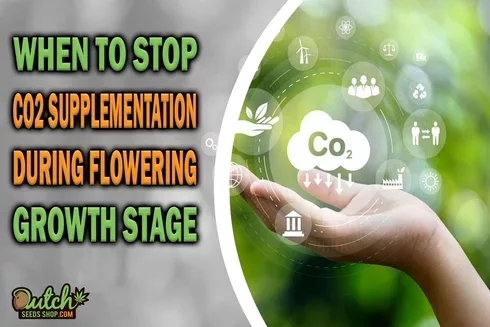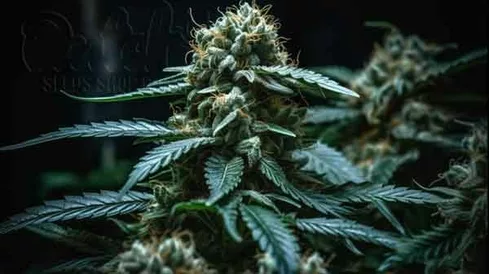When to Stop CO2 Supplementation During Flowering Stage
CO2 supplementation plays a crucial role in the overall health and productivity of cannabis plants, particularly during the flowering stage. It is essential to manage CO2 levels properly to achieve the best possible yield and quality of your harvest. This comprehensive guide will help you understand the importance of CO2 supplementation, its effects on plant…

The Importance of CO2 Supplementation
Carbon dioxide (CO2) is a vital component in photosynthesis, which is essential for growth of cannabis plants.
Supplementation of CO2 in the grow room can significantly enhance plant growth, yield, and overall health.
Benefits of CO2 Supplementation
In flowering stage, CO2 supplementation offers several benefits for cannabis plants:
- Increased growth rates: Higher CO2 concentrations promote faster plant growth, which can lead to more significant yields.
- Improved yields: Adequate CO2 levels during flowering can increase the size and density of buds, leading to a more bountiful harvest.
- Enhanced overall plant health: Proper CO2 management contributes to better nutrient uptake, stronger stems, and increased resistance to pests and diseases.
Role of CO2 in Flowering Cannabis Plants
CO2 plays a crucial role in the development and growth of flowering cannabis plants. It influences the plant’s metabolism and aids in the formation of buds.
CO2 supplementation during flowering increases the rate of photosynthesis, providing the necessary energy and essential elements for bud development and maturation.

Schedule for Stopping CO2 Supplementation
Knowing when to stop CO2 supplementation while the plants are in flowering stage is crucial to ensure the best possible harvest.
The optimal timing may vary based on factors like strain, growing conditions, and the size of the growing space.
It is generally recommended to stop CO2 supplementation during the last two weeks of the flowering stage.
That allows the plants to focus on the ripening process and the development of essential chemical compounds that contribute to aroma, flavor, and potency.

Signs to Look For
To determine when it’s time to stop CO2 supplementation during the flowering stage, look for the following signs:
- Swollen buds: Buds appear full and heavy, indicating they have reached their maximum size.
- Trichome development: Trichomes covering the flowers are fully developed and exhibit the desired color (usually milky white or amber).
- Decreased nutrient uptake: The plant begins to consume fewer nutrients, indicating that it is nearing the end of its life cycle.
Risks of Continuing CO2 Supplementation
Continuing CO2 supplementation during the late flowering stage can adversely affect plant health, bud development, and final yield.
Potential Problems
Potential issues that may arise from continuing CO2 supplementation during the late flowering stage include:
- Reduced bud density: Excess CO2 can lead to looser and less dense buds.
- Delayed ripening: High CO2 levels can slow the ripening process, potentially affecting the final harvest’s quality.
- Negative impact on taste and aroma: Excess CO2 during late flowering may alter the delicate balance of chemical compounds responsible for the plant’s aroma and flavor.
Tips for Optimal CO2 Management During Flowering
To ensure optimal CO2 management during the flowering stage, it is crucial to monitor CO2 levels, adjust the growing environment, and maintain a smooth transition from the vegetative to the flowering stage.
Monitoring CO2 Levels
Regularly monitoring CO2 levels is essential for achieving the best results.
Some tools that can help maintain optimal CO2 levels include:
- CO2 meter: An accurate CO2 meter can help you measure CO2 levels in your grow room, ensuring they remain within the desired range (typically 1000-1500 ppm during flowering).
- CO2 controller: A CO2 controller can automate CO2 supplementation by adjusting the levels based on sensor readings and the desired target concentration.
- Grow room monitor: A grow room monitor can track various environmental factors, including CO2 levels, temperature, and humidity, allowing you to make necessary adjustments in real time.

Adjusting the Growing Environment
To ensure optimal CO2 levels during the flowering stage, it’s crucial to control temperature, humidity, and ventilation in your grow room:
- Temperature: Maintain temperatures between 75-85°F (24-29°C) during the flowering stage to promote CO2 uptake and efficient photosynthesis.
- Humidity: Keep relative humidity around 40-50% during flowering to prevent mold growth and ensure proper transpiration.
- Ventilation: Proper air circulation and ventilation help distribute CO2 evenly throughout the grow room, ensuring all plants receive an adequate supply.
FAQ
What should CO2 levels be in the flowering stage?
CO2 levels during the flowering stage should typically be between 1000-1500 ppm to promote optimal growth and bud development.
Should I use CO2 during flowering?
Yes, CO2 supplementation during the flowering stage can significantly improve growth rates, yields, and overall plant health.
Does CO2 make bigger buds?
Adequate CO2 levels during flowering can lead to larger, denser buds and increased yields.
Does CO2 shorten the flowering time?
CO2 supplementation can accelerate plant growth but may not necessarily shorten the overall flowering time. It’s essential to monitor the plant’s progress and adjust CO2 levels accordingly.
Does CO2 increase yield?
Proper CO2 supplementation can increase yield by promoting faster growth and more significant, denser buds.
How high is too high for CO2?
CO2 levels above 1500 ppm during the flowering stage can lead to diminishing returns and potential adverse effects on plant health and harvest quality.
About the Author
Share the Love:
